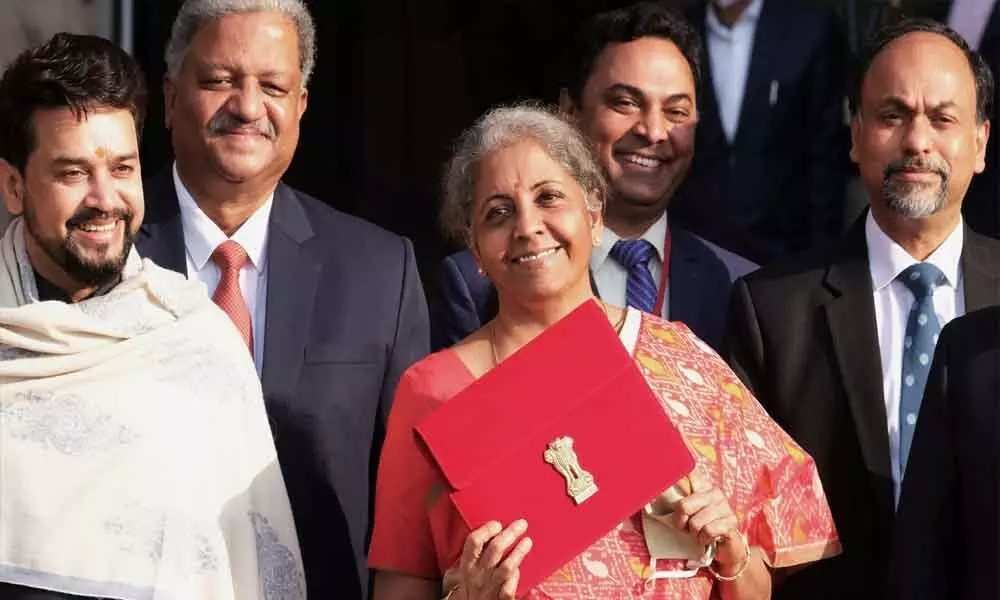Can India spend its way to a v-shaped recovery?
The country’s new Budget is good news for equity markets but bond investors are in sticker shock
image for illustrative purpose

India's annual Budget presented on Monday made equity investors ecstatic and the bond market morose. Could both of them be right?
In her speech, Finance Minister Nirmala Sitharaman pegged the total government expenditure for the current fiscal year at 34.5 trillion rupees ($472 billion). That's $57 billion more than what analysts had forecast based on a muted April-to-November trend, extrapolated for a bump in December through March, the final four months of the accounting period. But not only is Sitharaman spending much more liberally than expected, she wants to loosen her purse strings by another $5 billion in the next fiscal year.
The equity market is happy for four main reasons. One, there was no major new tax - or an increase in tax rates - to meet the spending goal. Two, even as total outlay goes up by $5 billion, the capital expenditure part, which could create new orders and profit for India Inc., is projected to rise by $15 billion. Third, the finance minister's promise of a bad bank to take away commercial lenders' soured assets is giving the market hope that clogged-up credit will start to flow more freely. The government is also setting up a new 'development' financial institution to meet the needs of the infrastructure sector. Finally, the decision to allow foreign insurers to boost their stakes in local joint ventures to 74 per cent from 49 per cent is a welcome reform.
The bond investor, meanwhile, is nursing a rude sticker-price shock. The finance minister said the current fiscal year's budget deficit would be as wide as 9.5 per cent of gross domestic product, about 2 percentage points more than the consensus estimate. In the coming year, she wants to trim the shortfall, but not too drastically. A targeted deficit of 6.8 per cent of GDP will require New Delhi to borrow aggressively once again, both from the bond market and from citizens' small savings pool. All eyes are on the central bank. Given that the Reserve Bank also intends to buy the dollars flooding into India's stock market to keep the rupee from rising too much, there's a limit on how many government bonds it may purchase from banks.
India wants to spend its way to a V-shaped recovery and hoping that getting there would also ease the resource crunch. For instance, next year's Budget assumes a 17 per cent jump in tax revenue and a more than five-fold jump in state asset sales. With the spread of the virus contained - and inoculation expected to gather pace - these targets may not be as daunting as they appear.
Even then, a lot has to go right for financing issues to not raise their head during the year, especially if the US Federal Reserve decides to start tapering its asset purchases, raising borrowing costs for emerging markets. This leaves India with very little time to steady an economy that was slowing precipitously even before Covid-19. Disturbingly, India's protectionist turn - under the garb of self-reliance - continued in the Budget, with import tariffs going up on auto components and mobile-phone parts. This doesn't augur well for manufacturing, especially for smaller firms whose revival holds the key to employment.
After they fled locked-down urban centres, 60 million migrant workers - equivalent to Italy's population - found a halfway house in India's rural job guarantee last June. While demand for publicly funded low-wage jobs has since ebbed to 34 million, a fifth of Indians who lost their services, manufacturing and construction jobs are still working as farmhands or are unemployed.
Still, the pandemic has finally alerted India to some long-neglected priorities: Even after taking away the cost of vaccination, the $30 billion earmarked for health and wellbeing is a doubling of the pre-Covid-19 spending level. What remains to be seen is whether this money can actually be spent. Overall, too, execution will determine the outcome of India's high-risk spending plan. It'll decide whether the bond investor turns more sanguine about financing, or the equity market turns more sceptical of V-shaped growth. Perhaps the initial reaction of both will be proved a little right, and wrong. (Bloomberg)

